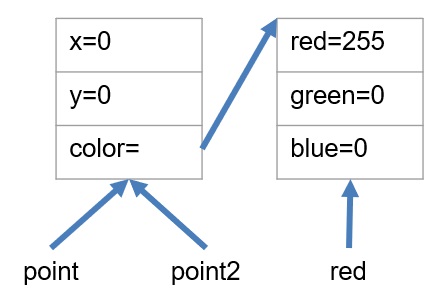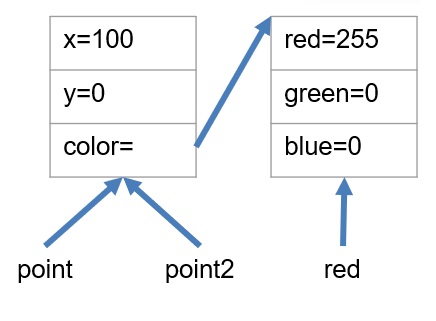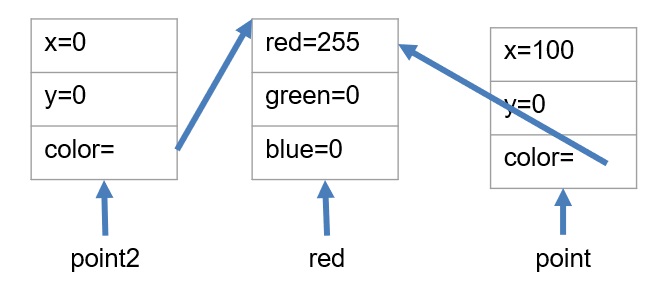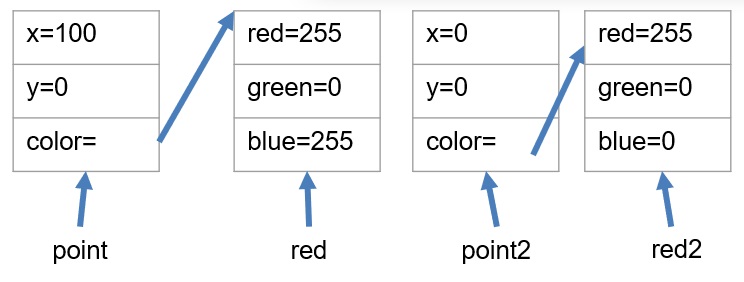Instances and References
Table of contents
Key Idea
When we create a new instance of a Data class, we create a new location in memory to store the data inside the class and are returned a reference.
Understanding Instances and References
When we define a class using the class keyword, we are creating a type. This type does not exist in memory, but is a template for creating objects that have the methods and fields described in the class. When we use the new keyword, we create an instance of the class in memory and return a reference to the object in memory. If we call the new keyword again, we get a second instance of the class and a second reference to a new memory location.
import { Color, Point, Polygon } from "ch2/drawing1";
let red: Color = new Color(255, 0, 0);
let points1: Point[] = [
new Point(0, 0, red),
new Point(100, 0, red),
new Point(50, 100, red),
];
let redTriangle: Polygon = new Polygon(points1, red);
console.log(redTriangle);
Examining this code in more detail, we see that each time new is called, we are creating an instance of the class. That means that each time we call new, we are allocating a new chunk of memory to hold the values of that instance. What is returned is not the value of the class but a reference to the created object.
Consider the following code:
let red: Color = new Color(255, 0, 0);
let point: Point = new Point(0, 0, red);
let point2: Point = point;
Graphically, this looks like:

What would happen if we update point.x. In this case we would also update the instance pointed to by point2, because they are the same instance. When we set point2 = point; we are setting the variable point2 to contain the reference stored in point. Thus, they reference the same chunk of memory allocated by the one and only call to new Point(...).
Let’s see that in action.
import { Color, Point } from "ch2/drawing1";
let red: Color = new Color(255, 0, 0);
let point: Point = new Point(0, 0, red);
let point2: Point = point;
point.x = 100;
console.log(point2);

As you can see, updating point updates the memory location referenced by point which is the same memory location referenced by point2. In other words, we only have one point, but we have two references or aliases to that point. Changing either one alters the one and only object that the variables point and point2 refer to.
Note: Sometimes this is what we want, but sometimes it is not!
Later, we will look at other methods to create new objects based on existing objects, but for now, we would have to call new again and set point2 to that new object, then update its properties with the properties of point.
import { Color, Point } from "ch2/drawing1";
let red: Color = new Color(255, 0, 0);
let point: Point = new Point(0, 0, red);
let point2: Point = new Point(point.x, point.y, point.color);
point.x = 100;
console.log(point);
console.log(point2);

This is a shallow copy of an object as we are only copying the top level. This will make a new object, but only copy the top level or primitive types (number, Boolean, string). Any deeper objects or arrays still remain as references.
What if we want a deep copy? In other words, each point will, in addition to having a unique memory location for its primitive values, will also have a reference to a different Color object.
import { Color, Point } from "ch2/drawing1";
let red: Color = new Color(255, 0, 0);
let red2: Color = new Color(255, 0, 0);
let point: Point = new Point(0, 0, red);
let point2: Point = new Point(point.x, point.y, red2);
point.x = 100;
console.log(point);
console.log(point2);

This is probably what we wanted. This is called a deep copy. While there are some ways to do this automatically in TypeScript, they do not work in all cases, and can be problematic. We can do this manually as in this example, but we will look at better ways later.
Summary
Understanding references and instances is critical in nearly all programming languages. In TypeScript, every variable whose type is not a primitive type (string, Boolean, number) stores a reference to the object. From our examples:
- point2=point; //makes a copy of the reference to the one and only object
- A shallow copy of the object only copies the top level primitive types, but does not duplicate any contained objects, rather it copies the reference to the same object.
- A deep copy of the object makes copies of all of the objects, nested objects and primitive types. This gives you a true clone of the object that is independent of the original. Later, we will learn how to clone the object, but for now, we have to create an independent object with the same values.
Next Step
Next we’ll learn about the this keyword »